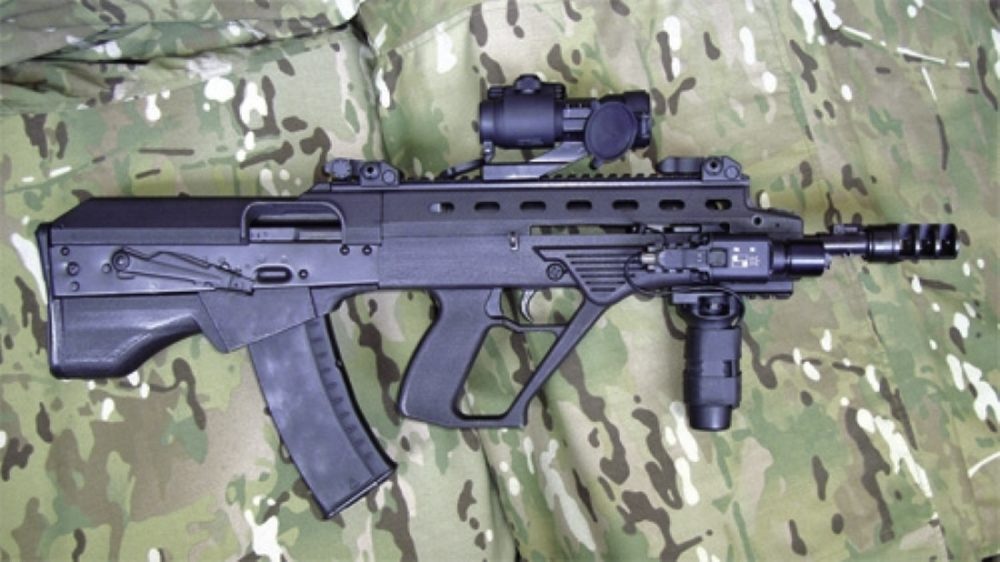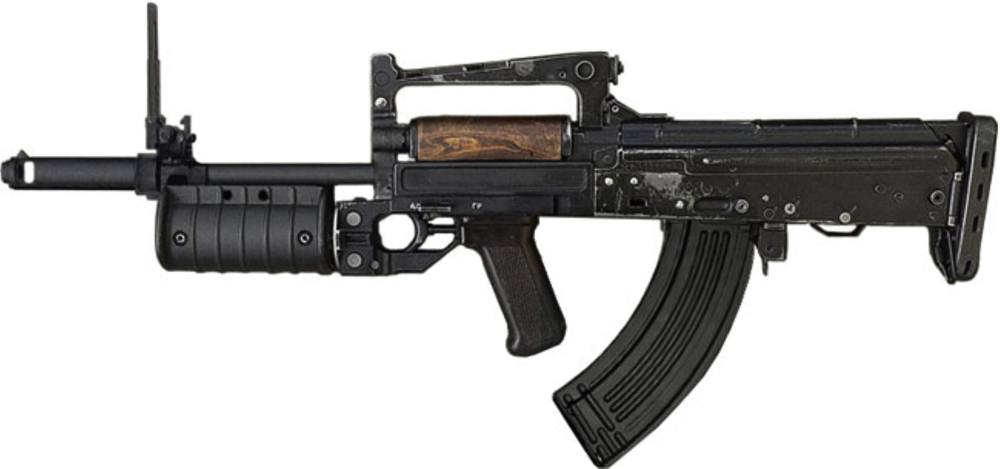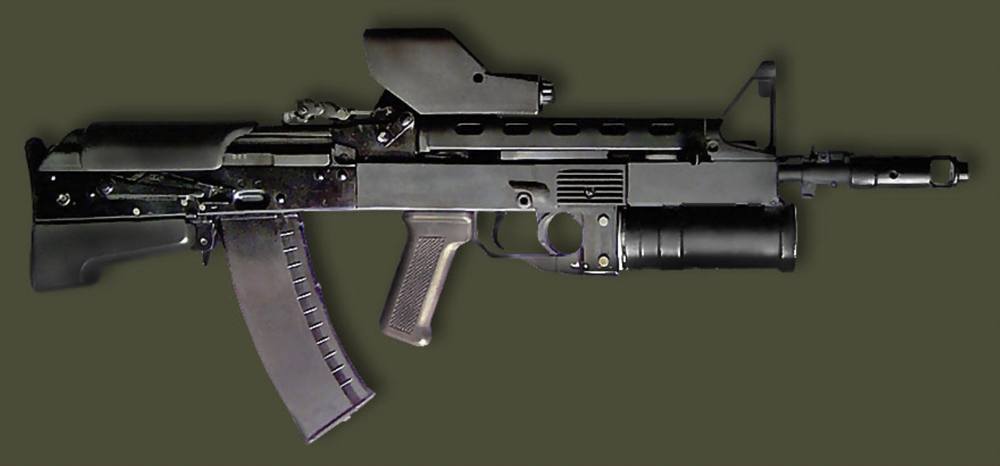
The K-3 Armenian Avtomat is an AK bullpup configuration. Here’s how this oddball and related AK variants came to be.
The advantage of the K-3 AK:
- Designed sometime prior to 1996, the K-3 AK bullpup is based on the standard AK-74 rifle.
- According to the bullpup’s designers, it’s cheaper, more accurate and has less recoil.
- Bullpup AKs were issued to Russian special forces.
- The Ukrainian version of the bullpup AK is the Vepr Avtomat.

Reconfigured Variants – AK Bullpups
Apart from the licensed and unlicensed AK-74 copies, there were a couple of variants that were simply made out of existing rifles. These were reconfigured externally by the engineers to comply with requirements of their respective militaries and were re-issued as locally made rifles with local designations.
The K-3 is an Armenian Avtomat of the bullpup configuration. It was developed by the Defense Industry Department of the Ministry of Defense of Armenia in 1996. The K-3 bullpup is based on the standard AK-74 rifle and entered service with the Armenian Defense Force in 1999. Today the K-3 sees limited service with special operations troops in Armenia, and was never intended or supplied for export.
- Weight: 2.7 kg
- Length: 700mm
- Barrel length: 415mm
- Caliber: 5.45X39mm
- Rate of fire: shots/min: 600-650 rounds/second
- Muzzle velocity: 900 m/s (2,953 fps)
- Aim range: 400 meters (437 yards)
- Feed: standard AK-74 30- or 45-round magazines

Very little is known about this variant, only that for the first time the K-3 5.45mm Avtomat was introduced to a wide audience in 1996. Despite the fact that the principle of operation is practically identical to the standard AK-74, its bullpup configuration is drastically different. Part of the gun’s trigger group (hammer to be precise) and the magazine are located behind the pistol grip and the trigger.
Typically, the Kalashnikov safety/selector lever is left in the back of the receiver. The ejection of empty casings is to the right, making shooting from the left shoulder difficult. Sights are made on high blocks, diopter rear sight is adjustable in range. The muzzle brake has a modified design to facilitate the launching of 3K-3 fragmentation grenades also developed in Armenia. To fire a rifle grenade, a regular live cartridge is used.
The K-3 Avtomat is similar to the AK-74. However, according to the gun’s creators, it is cheaper and more accurate, and has less recoil. The Armenian bullpup is made mostly out of metal. Its design includes an accessory rail for mounting a standard 4X-power PSO-1 optical sight, which is also produced in Armenia.
Regardless, it’s commendable for any country to develop and produce a firearm of its own design, especially such a small country like Armenia. The fact remains that most of the former Soviet republics have stockpiles of awesome Soviet-built AKMs and AK-74s. Not using free, proven guns that you already have is like pissing against the wind. Why do it? That’s why the bulk of the Armenian armed forces are armed with the best variants of Soviet-built 7.62mm and 5.45mm AKs.
Get More Bullpup Info:
- 5 Best Bullpup Shotgun Options For Compact Defense
- Nimble Advantage: Best Bullpup Rifle Options
- So, You’re In The Market For An SKS Bullpup…
- Gun Review: The IWI Tavor SAR Bullpup
- Escort BTS Bullpup Shotgun
One more bullpup comes to us from the Ukraine. We all know about the Vepr rifles here in the U.S., but this one is of a different breed.
After the collapse of the Soviet Union, each of its former republics tried to prove independence in all possible ways and, naturally, without creating firearms of their own design the independence would not be complete.

Because providing its armed forces with domestically produced weapons is the best proof of the country’s independence, the Ukraine was actively proving its independence in this way. As it turned out, there were a lot of people in the Ukraine who had pretty good and original ideas about firearms, as well as a well-developed scientific and industrial base that could easily be employed in development of such firearms.
The Ukrainian version of the bullpup AK was the Vepr Avtomat. This gun was introduced in 2003, and was developed in association with a rather interesting organization, the Scientific and Technical Center for Precision Engineering of the National Space Agency of Ukraine.
At the time of its introduction, there were jokes floating around about the type of weapon the Vepr represented, considering the entity that made it. Most popular was that the Vepr was a gun for the space wars. However, all jokes aside, the new Avtomat turned out to be nothing to laugh at. When the Vepr was released, some specialists compared it to the infamous Russian special purpose weapon complex, the Groza. I would not go as far as agreeing with those specialists, but in many respects such a comparison is valid.
Just like the Groza, the Ukrainian Vepr was based on the AK-74, and also like the Groza, the Vepr was configured as a bullpup Avtomat. However, unlike the Groza, the new Ukrainian Avtomat was not chambered for 9x39mm or 7.62x39mm (calibers used by the Russian Groza), but for the 5.45x39mm cartridge. Even though the Vepr acquired some Groza features that are common in bullpup guns, it did not acquire the Groza’s characteristics.

The main feature of the Vepr is that it was possible to maintain the maximum compatibility of parts and assemblies with the AK-74. This was very important for the Ukrainians, since they inherited a huge stockpile of AK-74 Avtomats after the fall of the Soviet Union. The considerable numbers of Soviet AKs provided the barreled actions for the new guns, and an almost infinite source of repair parts and assemblies.
The weight of the new Avtomat is 3.45 kgs (7.6 lbs.) empty; the length is only 702mm (27.64 inches), with a barrel length that is standard for a full-length Avtomat, at 415mm (16.34 inches). That is where the differences from the AK-74 end. The muzzle velocity is 900 m/s (2,953 fps), the automatic rate of fire is 600 rounds per minute, and the gun feeds out of standard 30- to 40-round AK-74/RPK-74 magazines. Basically, the new Vepr is the AK-74 in bullpup configuration.
However, the new Ukrainian gun had several advantages over its Soviet counterpart. Combined with the fact that the Vepr uses the 5.45×39 cartridge that already has a low impulse, the bullpup configuration produces better accuracy when fired in full-auto mode.
The gun became more manageable at that rate. The Vepr kept the performance characteristics of its full-length cousins but offered a far more compact package. One may ask, why isn’t everybody converting their AKs to bullpup configuration? There are several reasons.

In the bullpup configuration, the Avtomat lost its balance. This takes getting used to when firing. The ejection of spent casings to the right, with typical AK “gusto,” makes it impossible for a lefty to use this gun. Even when a right-handed shooter uses it, the face is way too close to the ejection port. Inhaling the powder gases caused irritation in the shooter’s throat and eyes. Not the most pleasant feeling.
The magazine change is cumbersome to say the least. Unlike AR-style magazine retention, where the mag is simply pushed into the mag-well, the AK mag has to be rocked into retention, not an easy thing to do under one’s armpit. The sight line (sight radius) had been shortened, negatively affecting long-range accuracy.
However, any modern optical or collimator sight takes care of that. When scrutinizing the Ukrainian Vepr, one must remember that shooters can get used to the new configuration and become proficient with magazine changes, leaving only the one serious shortcoming—the location of the ejection port in relation to the shooter’s face.
In addition to the gun’s layout, changes were made to the controls. Immediately noticeable is the placement of the charging handle. It has been moved ahead over the barrel and it is no longer reciprocal, i.e., it remains in place when the gun is fired. The charging handle could be placed on either side for right- or left-handed operation. The safety lever on the Vepr is a lateral button that is located above the trigger, which is an improvement compared to the standard AK.

However, a more important design element of the Vepr is the fact that handguards and other components are not affixed to the barrel, making it almost a floating barrel if not for the gas block. This design feature played a significant role in improving the accuracy of the gun.
The early models of Vepr were equipped with sights taken directly from the AK, but as the sighting line was reduced due to a change in the weapon’s layout, it was decided to replace standard AK “U”-slot rear sights with a diopter or “peephole” type. Both sights are mounted high and both fold out of the way of reflex, collimator or optical sights. The Vepr Avtomat is configured to accept a wide range of such aiming devices.
Initially, the Vepr was developed to accept the grenade launcher similar to the Russian Groza complex. This way one would designate the Vepr as a complex and not just an Avtomat. Unfortunately, the standard GP-25 grenade launcher was not compatible with the gun in bullpup configuration. A special modification had to be developed.
It turns out that, with the grenade launcher installed, the gun is more stable when firing. Its balance becomes more evenly distributed, although the weight of the gun is increased. An interesting detail is that when the grenade launcher is installed, the Avtomat’s safety also becomes the grenade launcher safety. This totally makes sense.
In the end, the Ukrainian-built Vepr Avtomat is just another version of the AK-74. I’m sure its creators would argue until red in the face that it is the next step in the AK development, citing how they were able to improve accuracy and reduce the dimensions.

But, you don’t need to be Samuel Colt or John Browning to see that it’s just the same gun dressed in prettier rags. Also, with positives like accuracy and reduced dimensions, the Vepr also inherited all the bullpup configuration shortcomings, like cumbersome magazine changes and rear-heavy balance, among others.
I read somewhere that Vepr creators claimed the Vepr had fewer parts than its AK predecessor. Well, again, no special education required to see that their claim is erroneous. They removed the stock and the lower and upper handguards, and added a massive butt plate, cheek piece, trigger linkages, two-piece lower handguard, gas tube cover and folding sights. Basic mathematics is not in their favor.
Today, Vepr Avtomats see service along with standard-configuration Soviet-built AK-74s in the hands of the Ukrainian armed forces. However, they are not widely used or issued to the regular infantry troops. Use of the Vepr is reserved to where its compactness is a requirement.
The rest of the troops have to be content with Mr. Reliable AK-74 Kalashnikov Avtomat. It was always easier and cheaper to grab a ready and proven gun from the warehouse than to create and mass-produce something new. Today, the Vepr project is suspended.
Editor’s Note: This excerpt is from AK-47: Survival and Evolution of the World’s Most Prolific Gun, available now at GunDigestStore.com.

Next Step: Get your FREE Printable Target Pack
Enhance your shooting precision with our 62 MOA Targets, perfect for rifles and handguns. Crafted in collaboration with Storm Tactical for accuracy and versatility.
Subscribe to the Gun Digest email newsletter and get your downloadable target pack sent straight to your inbox. Stay updated with the latest firearms info in the industry.

![Best Concealed Carry Guns In 2025 [Field Tested] Wilson Combat EDC X9S 1](https://gundigest.com/wp-content/uploads/Wilson-Combat-EDC-X9S-1-324x160.jpg)


![Best 9mm Carbine: Affordable PCCs [Tested] Ruger Carbine Shooting](https://gundigest.com/wp-content/uploads/Ruger-Carbine-Shooting-100x70.jpg)
![Best AR-15: Top Options Available Today [Field Tested] Harrington and Richardson PSA XM177E2 feature](https://gundigest.com/wp-content/uploads/Harrington-and-Richardson-PSA-XM177E2-feature-100x70.jpg)
